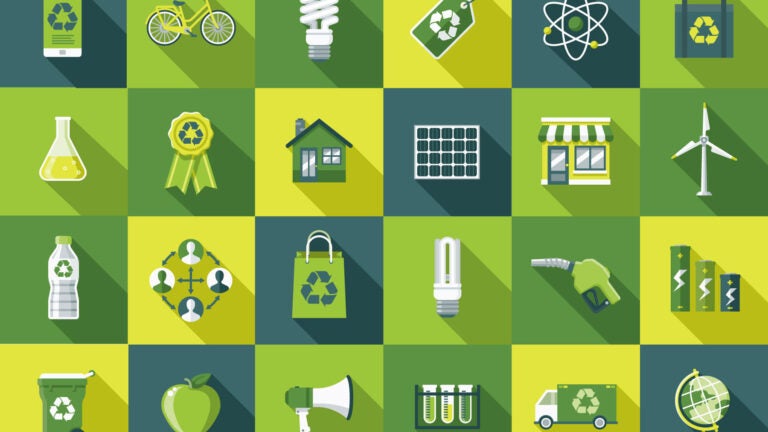
Since arriving at USC, President Carol L. Folt has championed sustainability and environmental action. (Illustration/iStock)
USC launches new sustainability research initiative
The initiative’s first three projects will focus on major environmental concerns in Southern California: water management, air pollution and testing for nutrients in soil.
USC has launched a new research initiative focused on sustainability, beginning with three new projects to address urban environmental challenges that vex Southern California.
The projects, announced earlier this month, include a study on smog-busting building materials, a diagnostic device to promote sustainable agriculture and human health, and a new federal research hub at USC to promote water management. The topics were selected by faculty experts because they benefit the region and have potential applications worldwide.
The endeavor signals a new role for the USC Center for Sustainability Solutions as a catalyst for interdisciplinary research. The center’s mission is to promote science, policy and engineering to find practical solutions to real-world problems.
“USC’s high-quality and cutting-edge scholarship is an asset that can be applied to solving big environmental challenges, first in Los Angeles and then around the world,” said Provost Charles Zukoski. “Collaborations among faculty, schools and community partners will be key to building USC’s sustainability research efforts and making cleaner, more just and livable cities.”
Since taking the helm at USC one year ago, President Carol L. Folt has identified sustainability as a top priority. She’s an environmental scientist-turned-executive with a vision for transforming the university into a leader for sustainability solutions in California. In one of her first official actions, she appointed a presidential working group consisting of USC faculty and staff environmental leaders who have recommended expanding collaborative research on sustainability.
Sustainability research at USC examines livable cities, managing water, nutrient testing
While the inaugural awards provide a combined $150,000 for three projects, they are an important part of a wider effort to direct USC research and curriculum to meet challenges like climate change, the urban future and social equity.
“This is just the start of an important chapter for USC and the Center for Sustainability Solutions,” said Mahta Moghaddam, co-director of the center and professor of electrical and computer engineering at the USC Viterbi School of Engineering.
For one project, researchers will explore how to use new architectural coatings to convert air pollution into innocuous chemicals to “eat smog and make our cities more livable,” according to the proposal.
It’s an idea that’s been around for a while, and the technology is being applied to select buildings in Mexico and Italy. The Los Angeles region is the smoggiest metro area in the United States. Doris Sung, undergraduate chair and associate professor at the USC School of Architecture, is the principal investigator of a large team.
Another project aims to establish USC as a center for water resource characterization and modeling to achieve long-term water sustainability for California. The state’s water resources are under enormous pressure due to whipsaw wet and dry cycles, population growth, droughts and climate change. Increasingly, Southern California, as the more dry half of the state, is in constant need of ways to do more with less water. To that end, USC seeks to establish a federally supported engineering research center to utilize big data, advanced sensing systems and networks, AI and physics-based computer models to manage water.
Our goal for the center and for USC is to become the hub of sustainability solutions in Southern California and the United States.
Detlof von Winterfeldt
The National Science Foundation supports environmental research centers at select universities around the United States. The centers emphasize partnerships, convergent research and practical solutions to societal problems. The federal government investment is intended to strengthen the competitive position of American industry in the global marketplace.
The principal investigators for the proposed water center are Felipe de Barros of USC Viterbi; Yolanda Gil of the USC Information Sciences Institute, Department of Computer Science and Spatial Sciences Institute; and John P. Wilson of the Spatial Sciences Institute, part of the USC Dornsife College of Letters, Arts and Sciences.
A third project seeks to promote crop yields and public health by developing a portable testing device to check nutrients in complex biological systems, including soil and human blood. It’s the brainchild of scientists at USC Viterbi, the Keck School of Medicine of USC and the School of Architecture.
Plants and people depend on nutrients, which can be detected by ions — electrically charged molecules. Testing the chemical composition of soil to grow crops or blood serum to monitor kidney health and other vital signs is important. But the tests can take time, could be expensive and may require equipment that is not readily accessible. The new USC research proposal calls for developing a portable ion sensing platform that can promote sustainable agriculture and better access to health care.
“Our goal for the center and for USC is to become the hub of sustainability solutions in Southern California and the United States,” said Detlof von Winterfeldt, co-director of the sustainability center and a professor at USC Viterbi and the USC Price School of Public Policy.
The Center for Sustainability Solutions is funded by USC Price, USC Viterbi and the provost. Its research advisory committee consists of faculty from the Keck School of Medicine, the School of Architecture, the USC Rossier School of Education, the USC Marshall School of Business and USC Dornsife.



